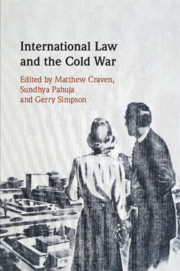Book contents
- International Law and the Cold War
- International Law and the Cold War
- Copyright page
- Dedication
- Contents
- Figures
- About the Editors
- About the Authors
- Acknowledgements
- 1 Reading and Unreading a Historiography of Hiatus
- Part I The Anti-linear Cold War
- Part II The Generative/Productive Cold War
- 4 Accounting for the ENMOD Convention: Cold War Influences on the Origins and Development of the 1976 Convention on Environmental Modification Techniques
- 5 Nuclear Weapons Law and the Cold War and Post–Cold War Worlds: a Story of Co-production
- 6 Parallel Worlds: Cold War Division Space
- 7 Shadowboxing: The Data Shadows of Cold War International Law
- 8 Contesting the Right to Leave in International Law: the Berlin Wall, the Third World Brain Drain and the Politics of Emigration in the 1960s
- 9 Bridging Ideologies: Julian Huxley, Détente, and the Emergence of International Environmental Law
- 10 More than a ‘Parlour Game’: International Law in Australian Public Debate, 1965–1966
- 11 Environmental Justice, the Cold War and US Human Rights Exceptionalism
- 12 The Cold War and Its Impact on Soviet Legal Doctrine
- 13 Forced Labour
- 14 Rupture and Continuity: North–South Struggles over Debt and Economic Co-operation at the End of the Cold War
- 15 The Cold War History of the Landmines Convention
- Part III The Parochial/Plural Cold War
- References to Cold War Volume
- Index
14 - Rupture and Continuity: North–South Struggles over Debt and Economic Co-operation at the End of the Cold War
from Part II - The Generative/Productive Cold War
Published online by Cambridge University Press: 05 December 2019
- International Law and the Cold War
- International Law and the Cold War
- Copyright page
- Dedication
- Contents
- Figures
- About the Editors
- About the Authors
- Acknowledgements
- 1 Reading and Unreading a Historiography of Hiatus
- Part I The Anti-linear Cold War
- Part II The Generative/Productive Cold War
- 4 Accounting for the ENMOD Convention: Cold War Influences on the Origins and Development of the 1976 Convention on Environmental Modification Techniques
- 5 Nuclear Weapons Law and the Cold War and Post–Cold War Worlds: a Story of Co-production
- 6 Parallel Worlds: Cold War Division Space
- 7 Shadowboxing: The Data Shadows of Cold War International Law
- 8 Contesting the Right to Leave in International Law: the Berlin Wall, the Third World Brain Drain and the Politics of Emigration in the 1960s
- 9 Bridging Ideologies: Julian Huxley, Détente, and the Emergence of International Environmental Law
- 10 More than a ‘Parlour Game’: International Law in Australian Public Debate, 1965–1966
- 11 Environmental Justice, the Cold War and US Human Rights Exceptionalism
- 12 The Cold War and Its Impact on Soviet Legal Doctrine
- 13 Forced Labour
- 14 Rupture and Continuity: North–South Struggles over Debt and Economic Co-operation at the End of the Cold War
- 15 The Cold War History of the Landmines Convention
- Part III The Parochial/Plural Cold War
- References to Cold War Volume
- Index
Summary
On 1 May 1990, during the 18th Special Session on international economic cooperation, the General Assembly passed a resolution supporting a ‘Declaration on International Economic Co-operation, in Particular the Revitalization of Economic Growth in Development of the Developing Countries’. The overarching framework of the Declaration is the ‘strong commitment to a global consensus to promote urgently international economic co-operation for sustained growth of the world economy’ and the revitalisation of economic growth in developing countries after the 1980s, ‘a decade lost to development’. The Declaration was the product of a ‘long and arduous negotiations’ and ‘protracted … discussions’ which, after its adoption, was celebrated as a ‘pioneering landmark in the annals of international economic co-operation’. In retrospect though, it has been all but forgotten.
Keywords
- Type
- Chapter
- Information
- International Law and the Cold War , pp. 287 - 314Publisher: Cambridge University PressPrint publication year: 2019
- 1
- Cited by

